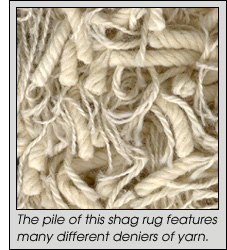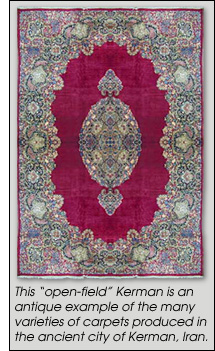Glossary
Learn the language of the loom!
Abrash - Dye lot changes in the yarn show up as a different shade of color usually in a horizontal line in the rug pile. Subtle abrash in tribal or village rugs enhances the folk art look. Abrash in city rugs is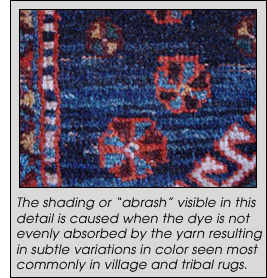
All Over Design - A repeat pattern that fully covers the field of a rug.
Arabesque - A design of intertwining vines, flowers and leaves common in Persian rugs.
Asymmetric Knot - A knot tied on two or more off-set warps; also called a Senneh or Persian knot.
Aubusson - Elegant and stylish, this French classic usually is made in muted colors with a medallion design. The name comes from a French factory in production in the 18th century.
Axminster Loom - A type of power loom used for manufacturing Oriental rug designs, because of their flexibility reproducing color and design.
Backing/Backing Material - To protect the back of tufted or hooked rugs, heavy fabric is secured with latex glue.
Bessarabian - Flat woven rugs, depicting stylized florals, of Romanian or Turkish origin.
Border - The design, which forms the outside edge of a rug and surrounds the field.
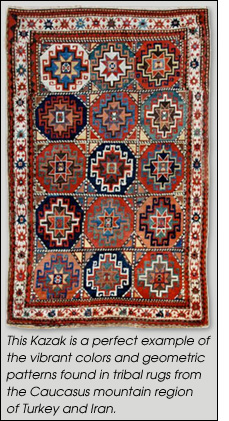
Cartoon - A colored drawing on graph paper of the rug design that a weaver follows when weaving a rug. Each square on the cartoon represents a single knot.
Carving - Hand-held carving tools are used to accentuate details of hooked, tufted and hand knotted rugs.
Caucasian - A generic name describing boldly colored geometric designs originating from Armenia, Azerbaijan, and other areas in the Causcasus mountain region.
Chemical Wash - Produces an overall lustre by reacting to the dyestuffs in the wool and by removing some of the wool scales from the pile.
Chrome Dyes - A high quality synthetic dye that uses potassium bichromate to form a permanent bond between the dye and the wool fiber.
City Rugs - Rugs that are produced in large metropolitan areas. City rugs are usually curvilinear and have a higher knot count than tribal rugs. Consistency in color, design, material, and weave determine the value in these rugs.
Cross-woven - This refers to a rug woven horizontally on a Wilton loom as opposed to vertically, which is more common.
Denier - In reference to yarn size, the lower the denier the smaller the yarn size, the higher the denier the larger the yarn size.
Density - This measure of quality is determined by the amount of yarn and the pile height in a given area in a power-loomed rug and the knot count in a hand knotted rug.
Dhurrie - Hand made flat weave from India, usually of muted colors in wool or cotton and very popular in the 80's.
Edge Wrap - The side of the rug is wrapped with thick yarn to secure the outer edges. This should be done during the weaving process.
Field - The part of a rug's design surrounded by the border. The field may be solid or contain medallions, or an overall pattern.
Foundation - The combination of warps and wefts in the body of a rug, usually made with cotton but also seen in wool and/or silk.
Hooked Rug - Rugs made when yarns are pushed through a canvas cloth, then latex glued on the back side to hold the yarns in place.
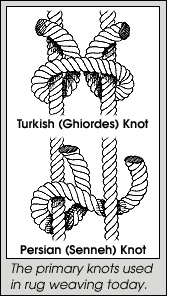
Kilim - Flat woven like a dhurrie, but usually in richer colors Kilims are extremely versatile. Kilims were used by weavers themselves in everyday life and are rich with cultural motifs. Utilitarian in origin, they're used for carrying and storing supplies.
Knot - Each yarn is tied around 2 or more warp cords to form a single knot. The number of knots per square inch is one of the quality factors in an Oriental rug.
Lines - Most hand knotted Chinese rugs are graded by line count, which indicates the number of knots per linear foot.
Medallion - If a design has a noticeable center motif, usually circular or star-shaped, it is called a center medallion.
Nap - Rugs have nap direction caused by the knotting direction. Due to light reflection, a knotted rug will look light at one end and dark from the other end. In older rugs, traffic patterns can cause nap distortion that can change the original nap direction.
Open Field - When the field of the rug has little or no pattern except a center medallion.
Persian - Persia encompasses an area larger than current day Iran, which includes parts of India, Afghanistan and Iraq, as well as groups of Nomadic people.
Pile - The cumulative cut ends of the knot result in a pile or face of the rug. Most rugs have wool pile, which some have silk or a combination of silk and wool pile. Pile is sometimes called the "nap".
Pile Height - The height of face yarns from the backing to the tip of the piece of yarn.
Ply - One or more yarns are twisted together to form a larger piece of yarn. Ply counts the number of individual yarn pieces comprising the whole.
Polypropylene - A synthetic fiber that is colorfast, mold and mildew resistant, stain resistant, with excellent wearability and is easily cleaned. Commonly replaces wool in power loomed rugs.
Power Loomed - Rugs that are "machine made" rather than hand knotted or hand tufted.
Raj - Iranian rugs use a knot count based upon raj. This is the number of linear knots in 7cm. A raj is actually the length of an unfiltered cigarette used as a uniform measure.
Root names - When Persian designs are produced in China the word "Sino" precedes the name of the design e.g.: Sino-Persian. If a Kerman design is produced in India it is called Indo-Kerman.
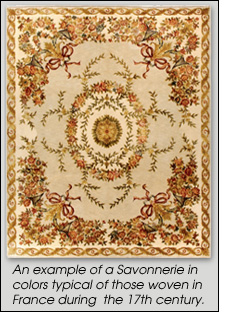
Staple - The average length of fibers in the wool.
Symmetric Knot - A knot tied on two or more parallel warps; also called a Ghiordes or Turkish knot.
Tribal - Handmade in villages or by nomadic tribes, these rugs - from Iran, Turkey, Afghanistan and the Caucasus - feature bold, geometric designs and are usually coarsely woven. Many tribal rugs are made of a wool warp and weft, unlike city rugs made with a cotton warp.
Tufting - Yarns are pushed through a cotton canvas to form a pattern with a hand held tufting gun. Then, latex is applied to hold the yarns in place after which a backing is applied.
Variegated - Using multiple colors.
Vegetable Dyes (also Vegetal dyes) - Natural dyes produced from berries, roots, insects, bark, and other natural sources. They are not as consistent as chrome dyes, but can produce wonderfully rich or subtle shades that have an organic feel not easily reproduced by synthetic dyes.
Warp - Hand-woven rugs have a long foundation running the entire length of the rug and can be seen as flat selvage and/or fringe at both ends. Most rugs use a cotton warp because of its consistent tension during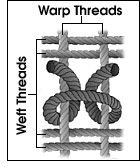
Weft - Horizontal threads are placed between warp threads after a row of knots is tied securing the knots. The number of weft threads between each row of know varies by region.
Wilton Loom - A type of automated loom popular for producing Oriental designed power loomed rugs and carpet.
Worsted - Before wool is spun into yarn, it is combed, and then twisted to improve its quality by leaving only longer pieces of fiber for final spinning.
